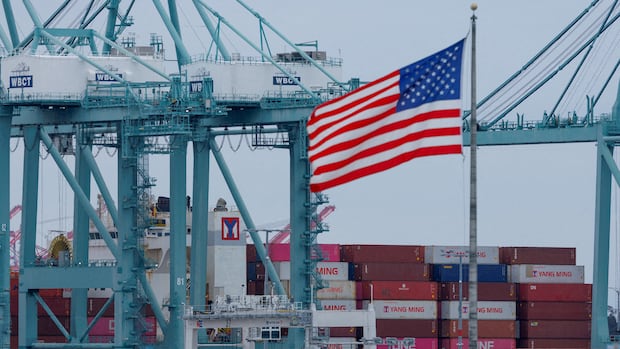U.S. President Donald Trump said Thursday that the U.S. would charge a 15 per cent tariff on imports from South Korea and extend the existing trade deal with Mexico for the next 90 days — two measures announced in the run-up to his Friday deadline to impose levies on countries around the world.
For Canada, there’s one day remaining in the deadline to reach a trade deal; otherwise, Trump has threatened to impose a 35 per cent tariff on goods that don’t comply with the Canada-U.S.-Mexico Agreement (CUSMA).
That rate would apply to Canadian exports currently being tariffed at 25 per cent under Trump’s emergency powers, which he enacted citing what he says is a national security threat from fentanyl trafficking.
He also signed an executive order imposing a 40 per cent tariff on Brazilian exports, bringing the country’s total tariff amount to 50 per cent, but with a number of notable exemptions.
He has also threatened to impose a 25 per cent tariff on goods imported from India starting on Aug. 1.
Here are key developments:
Mexico
Trump said Thursday that he had agreed with Mexican President Claudia Sheinbaum to extend an existing trade deal with Mexico for 90 days and continue talks over that period with the goal of signing a new deal.
“Mexico will continue to pay a 25% Fentanyl Tariff, 25% Tariff on Cars, and 50% Tariff on Steel, Aluminum, and Copper. Additionally, Mexico has agreed to immediately terminate its Non Tariff Trade Barriers, of which there were many,” Trump said in a Truth Social post.
Sheinbaum said in a post on X that she had a “very good” conversation with Trump that helped her country avoid a tariff increase.
South Korea
Trump said the U.S. will charge a 15 per cent tariff on imports from South Korea, including autos, as part of a trade deal, a figure that is down from the original 25
He also said South Korea would accept American products, including autos and agriculture into its markets and impose no import duties on them.
The U.S. agreed that South Korean firms would not be put at a disadvantage compared with other countries over upcoming tariffs on chips and pharmaceutical products, while retaining 50 per cent tariffs on steel and aluminum.
U.S. President Donald Trump sent letters to governments around the world on Monday, outlining the tariffs he would impose on Aug. 1. The recipients include Japan, South Korea and South Africa. Canada’s July 21 deadline to reach a deal with the U.S. appears to remain.
Trump said South Korea would invest $350 billion in the United States in projects “owned and controlled by the United States” and selected by Trump.
South Korea said $150 billion has been earmarked for shipbuilding co-operation, while investments in chips, batteries, biotechnology and nuclear energy co-operation accounted for the remaining $200 billion.
Trump said South Korea would purchase $100 billion worth of liquefied natural gas or other energy products, which the Asian country said would mean a slight shift in energy imports from the Middle East in the next four years.
Brazil
Trump slapped a 50 per cent tariff on most Brazilian goods to fight what he has called a “witch hunt” against former president Jair Bolsonaro but softened the blow by excluding sectors such as aircraft, energy and orange juice from heavier levies.
The new tariffs are due to take effect on Aug. 6 in the case of Brazil. But major exports including coffee and beef were not spared.
General exemptions also apply to donations intended to relieve human suffering such as food, clothing, medicine, as well as publications, films, music and artworks.
Brazil estimates that 35.9 per cent of its exports to the U.S. by value will be hit with those high rates, Vice-President Geraldo Alckmin said on Thursday.
India
Trump said on Wednesday the United States is still negotiating with India on trade after announcing earlier in the day the U.S. would impose a 25 per cent tariff on goods imported from the country starting on Friday.
India has resisted U.S. demands to open its agricultural and dairy markets, saying such moves would hurt millions of poor farmers. New Delhi has historically excluded agriculture from free trade pacts to protect domestic livelihoods.
According to a White House fact sheet, India imposes an average MFN (Most Favoured Nation) tariff of 39 per cent on imported farm goods, compared to five per cent in the U.S., with some duties as high as 50 per cent.
Washington is pushing for better access to India’s markets for agriculture, ethanol, dairy, alcoholic beverages, autos, pharmaceuticals and medical devices.
